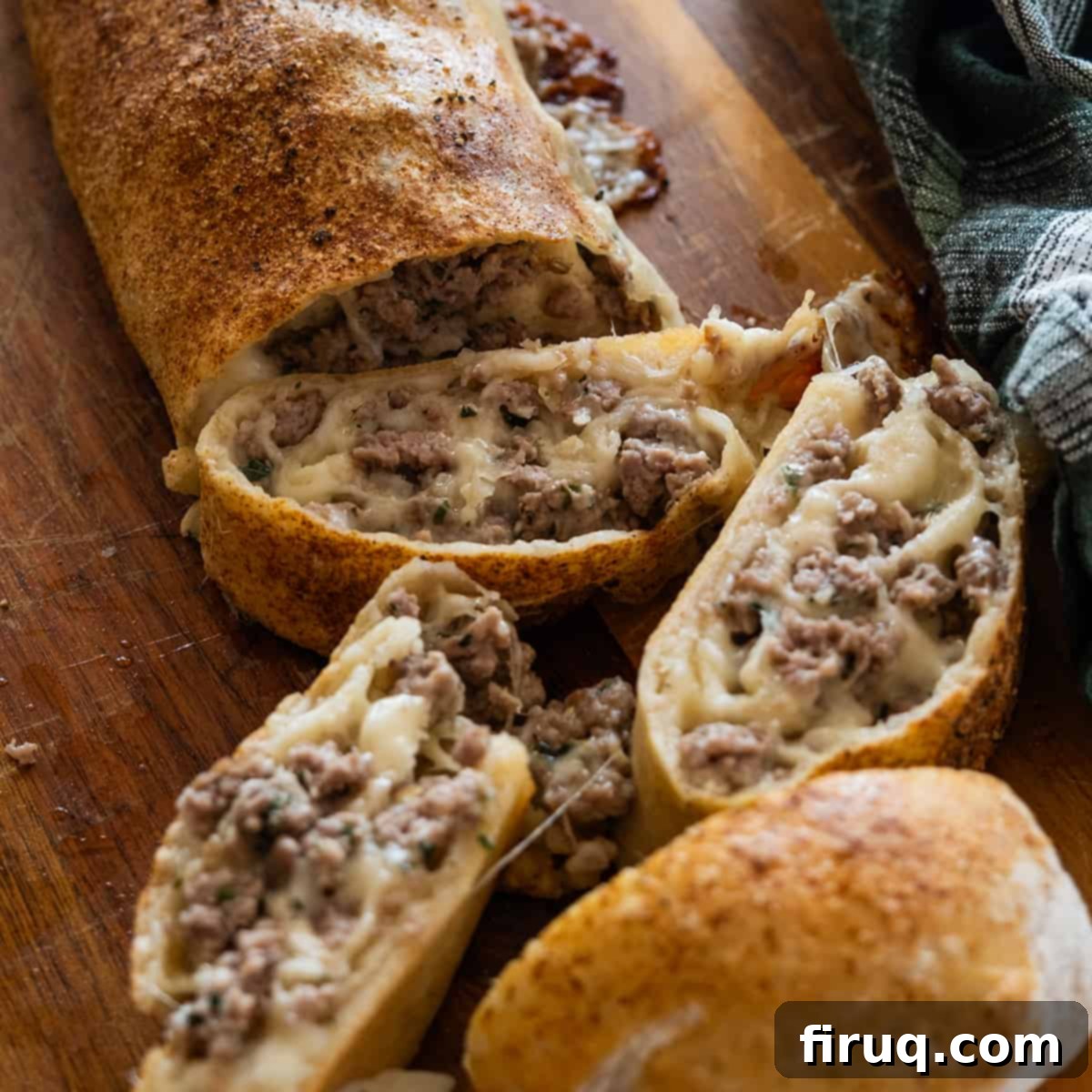Irresistible Italian Sausage Bread: Your Ultimate Cheesy Appetizer Recipe
Prepare to fall in love with this incredibly cheesy and savory Italian Sausage Bread, a crowd-pleasing appetizer that your family and friends will rave about. It’s so utterly delicious and addictive that you won’t even need to worry about leftovers – instead, you’ll find yourself planning to bake two loaves next time!
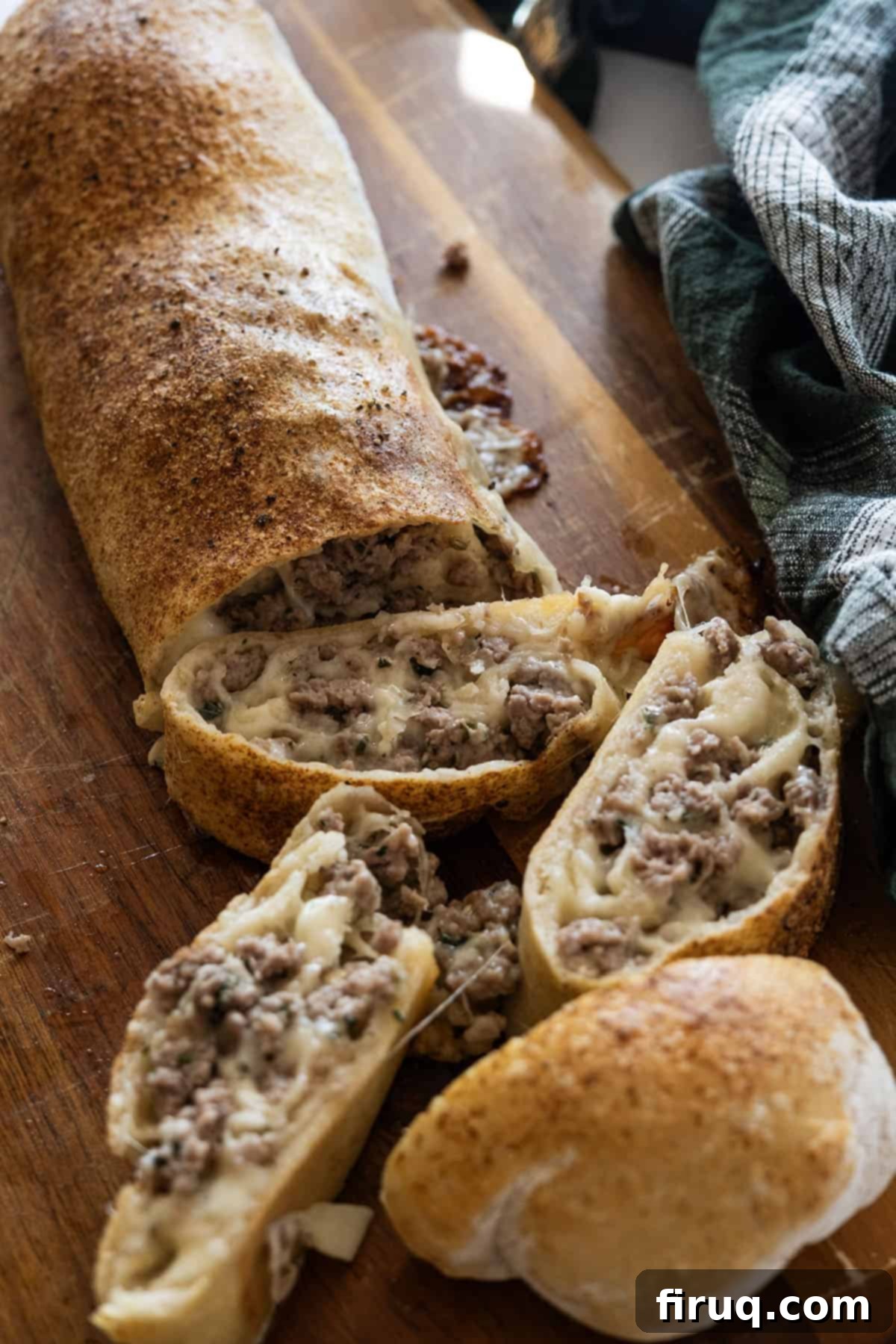
This savory bread, sometimes known as a “sausage roll” or a “filled bread,” is a staple at Italian-American gatherings, holidays, and game day parties. It brings together the beloved flavors of seasoned Italian sausage, a blend of rich cheeses, all encased in a tender, golden-brown pizza dough. Simple to make yet incredibly impressive, this recipe is guaranteed to be a hit at any occasion. It’s truly a labor of love that tastes like it came straight from an Italian bakery.
If you enjoy the delightful combination of bread, meat, and cheese, you’ll also adore our recipes for Pepperoni Bread (Stromboli), EASY Ricotta Bruschetta, and Eggplant Parmigiana. Each offers a unique taste of Italian-inspired comfort food.
This Italian Sausage Bread is more than just an appetizer; it’s a culinary experience. Imagine a golden crust, slightly crisp, yielding to a soft interior generously packed with crumbled, flavorful Italian sausage and gooey, melted mozzarella and provolone, with a hint of sharp Parmesan. Each bite is a symphony of textures and tastes, making it an unforgettable dish for any gathering.
Whether you’re hosting a holiday party, looking for a hearty game day snack, or simply craving a delicious and satisfying treat, this recipe delivers. Its robust flavors and comforting warmth make it perfect for cooler months, but it’s equally enjoyable year-round. Plus, it’s surprisingly simple to prepare, even for novice bakers. The key is in selecting quality ingredients and following a few easy steps to ensure a perfectly baked loaf every time.
Ingredient Notes and Expert Tips for Your Sausage Bread
Crafting the perfect Italian Sausage Bread begins with understanding your key ingredients. Here’s a detailed look at what you’ll need and how to make the best choices for a truly authentic flavor profile.
Choosing the Right Sausage
Sausage. The heart of this recipe lies in the quality and flavor of your Italian sausage. I often prefer to make my own homemade ground sausage mix using a custom blend of spices, or I opt for my pre-made Sweet Italian Sausage Seasoning when time is of the essence. Homemade sausage allows for superior control over the flavor and texture, ensuring a product free from fillers and unwanted additives.
When purchasing sausage, I typically steer clear of major commercial brands like Johnsonville or Premio, as I generally find their flavor profiles less appealing. Instead, I highly recommend sourcing your sausage from a reputable local butcher. Many good butchers offer high-quality, flavorful sausage that will significantly elevate your finished bread. Remember, every sausage is different, as butchers often customize their blends with various spices and seasonings. For this recipe, you can choose between sweet, mild, or hot Italian sausage, depending on your family’s preference. A sweet Italian sausage offers a classic, aromatic flavor, while a hot Italian sausage adds a delightful kick.
For those who love to cook from scratch, I make homemade Italian sausage and freeze it annually. I also have a fantastic recipe for Italian Ring Sausage, which boasts a wonderful medley of flavors that would be absolutely perfect for this sausage bread!
Selecting Your Dough
Dough. The foundation of a great sausage bread is excellent pizza dough. For a consistently reliable result, I use the pizza dough from Sip and Feast, but with a slight modification: instead of splitting it into four individual doughs, I divide it into two larger portions. You’ll need a fairly generous pizza dough, roughly 2 lbs, to accommodate 1 lb of sausage and a hearty amount of cheese. When I lived in New York, a convenient trick was to simply purchase fresh dough directly from a local pizzeria, which often has superior flavor and texture.
However, you don’t need a specialty pizzeria for great results. High-quality store-bought pizza dough is widely available. Brands like Trader Joe’s offer a good option, though their doughs tend to be smaller, usually around 1 lb. If using a smaller dough, be prepared to adjust your filling quantities accordingly or to make two smaller loaves. Ensure your dough is at room temperature before rolling for easier handling and a better rise.
The Perfect Cheese Blend
Beyond the sausage and dough, the cheese blend is crucial for that irresistible gooey texture and rich flavor. The combination of sliced mozzarella, sliced provolone, and grated Parmesan cheese creates a harmonious balance. Mozzarella offers stringy meltiness, provolone adds a sharper, saltier kick, and Parmesan contributes a nutty, aged depth. Feel free to adjust the ratios to your liking, or even experiment with other cheeses like a blend of sharp cheddar, fontina, or even a touch of ricotta for added creaminess. The goal is a generous layer that melts beautifully around the savory sausage.
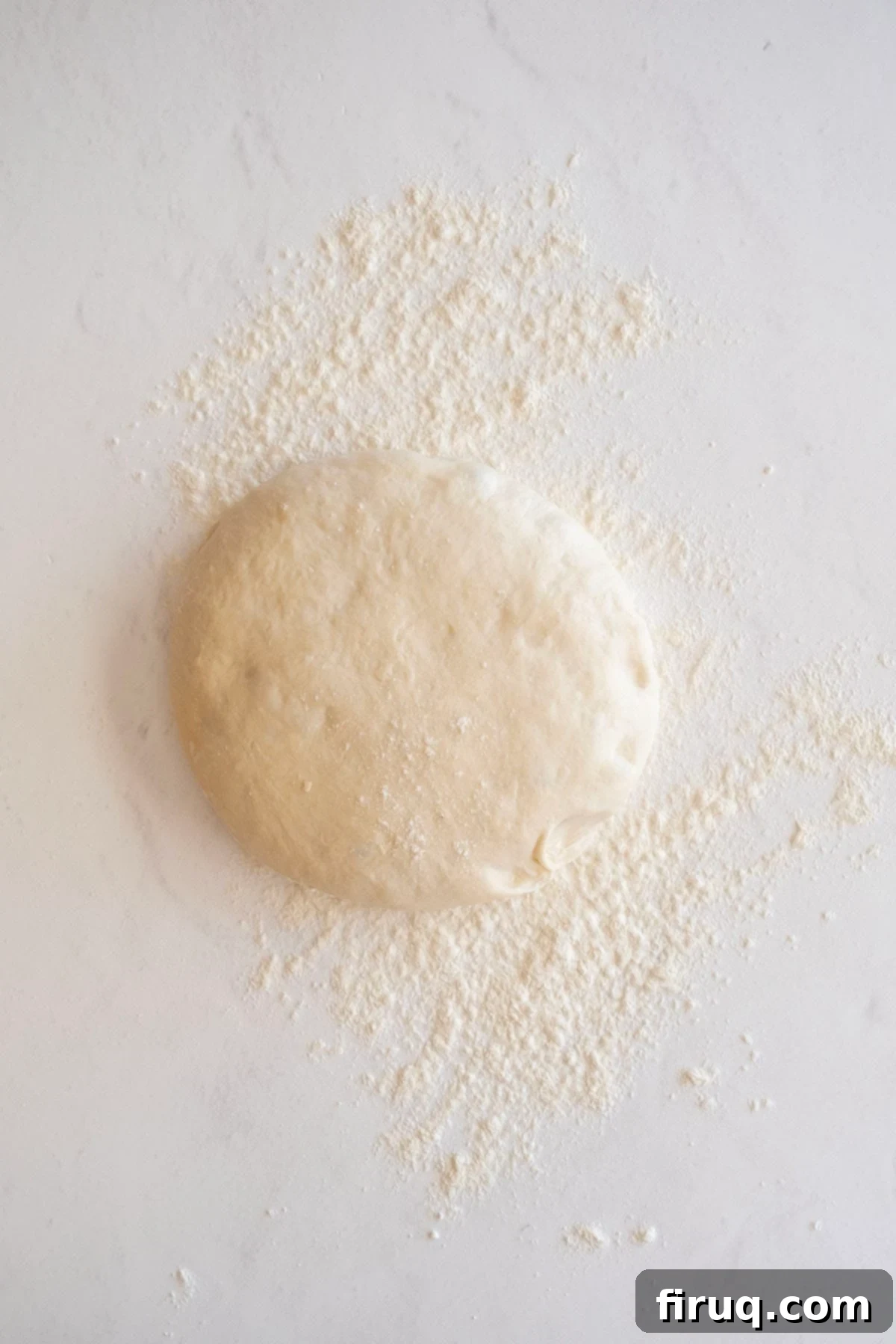
Easy-to-Follow Step-by-Step Directions
Making this Italian Sausage Bread is simpler than you might think! Follow these detailed steps to create a perfect loaf every time.
Step 1: Prepare the Sausage and Preheat Oven.
In a large skillet, brown the sausage over medium-high heat. Break it apart with a spoon as it cooks, ensuring no pink remains. The goal here is to cook the sausage most of the way through, but don’t worry about it being perfectly done, as it will continue to cook in the oven. Once browned, remove the sausage from the pan, drain any excess fat, and set it aside to cool slightly. It’s important for the sausage to be cool or at least lukewarm when it touches the dough to prevent the dough from becoming greasy or tearing. While the sausage cools, preheat your oven to 375℉ (190°C).
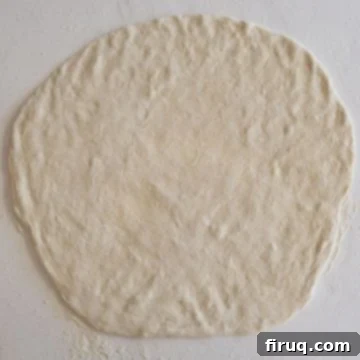
Step 2: Roll Out the Dough.
On a heavily floured surface, roll out your pizza dough. Aim for a rectangular shape, approximately 18×12 inches, and about ¼ inch thick. Think of it like a large, thin pizza base. The flour is crucial to prevent sticking, allowing you to easily transfer and roll the dough later. If the dough springs back, let it rest for a few minutes before continuing to roll.
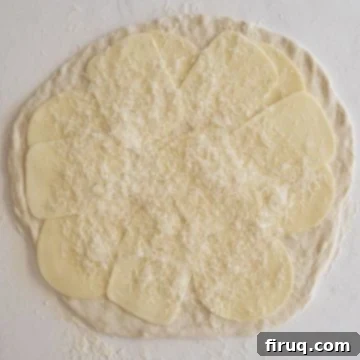
Step 3: Layer the Cheeses.
Begin by layering your slices of mozzarella and provolone across the rolled-out pizza dough. Arrange them so they cover as much of the dough as possible, leaving a small border (about an inch) around the edges. This border will help seal in the filling later. After laying the sliced cheeses, evenly sprinkle the Parmesan cheese across the entire surface. This blend ensures maximum cheesy goodness in every bite.
Step 4: Add the Sausage Filling.
Now, take your cooled crumbled sausage and spread it evenly over the cheese layers on the dough. Distribute it right up to the cheese border you created, ensuring every slice of the finished bread will have a generous amount of savory sausage. Cooling the sausage beforehand is crucial; hot sausage can make the dough sticky and difficult to roll.
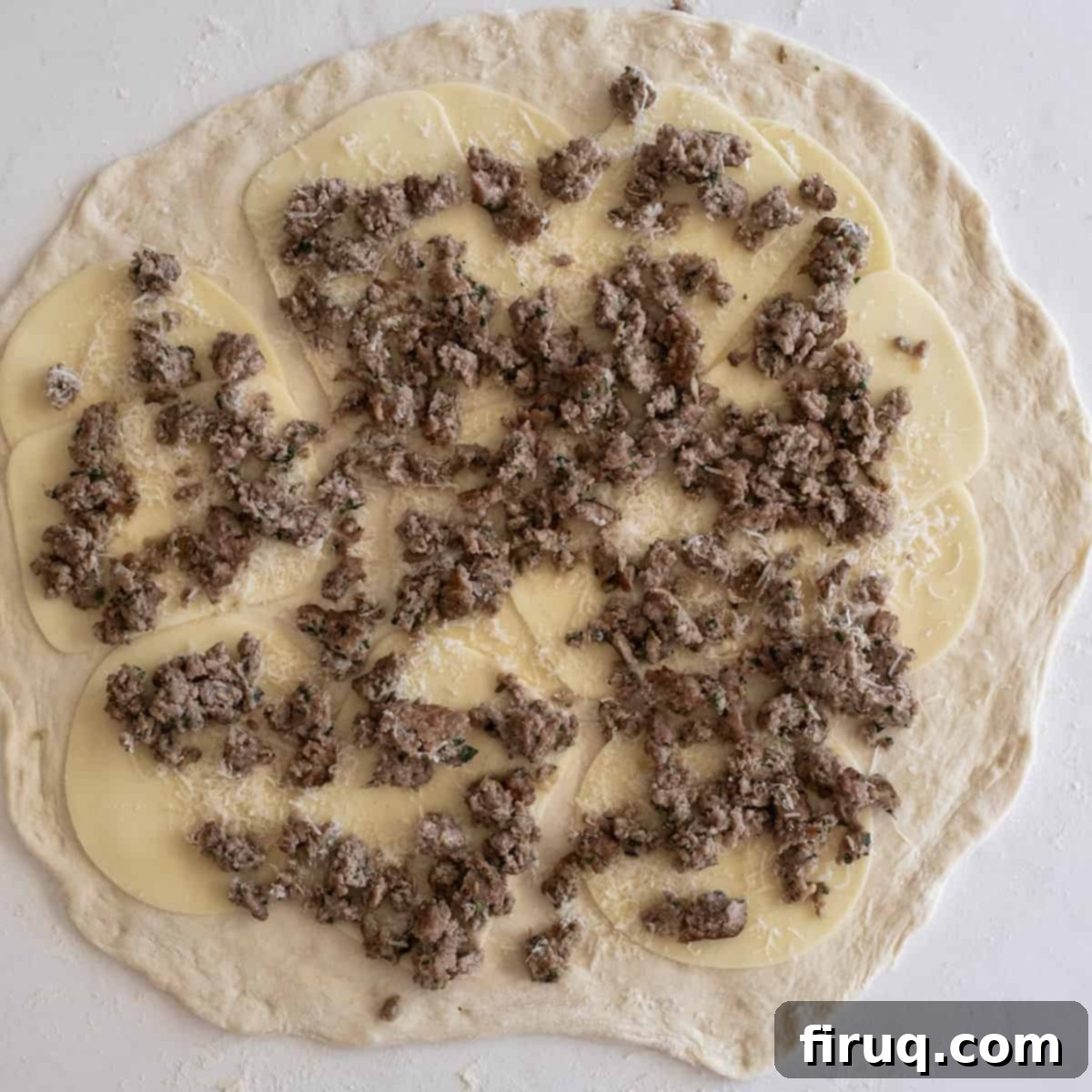
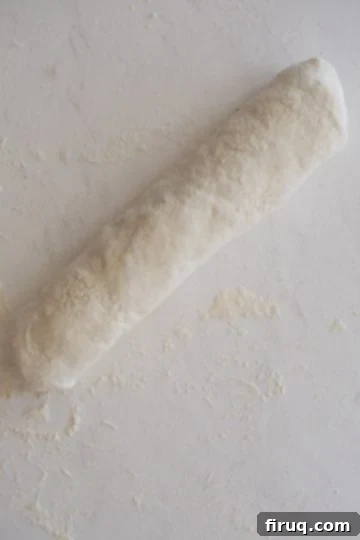
Step 5: Roll and Seal the Dough.
Carefully pull the edges of the dough slightly, ensuring there is a small amount of dough visible beyond the cheese and meat. Starting from one long end, begin rolling the dough tightly into a log or loaf shape. As you roll, make sure to fold the short edges inwards to seal the ends and prevent any of the delicious filling from escaping during baking. This step is crucial for maintaining the integrity of your sausage bread.
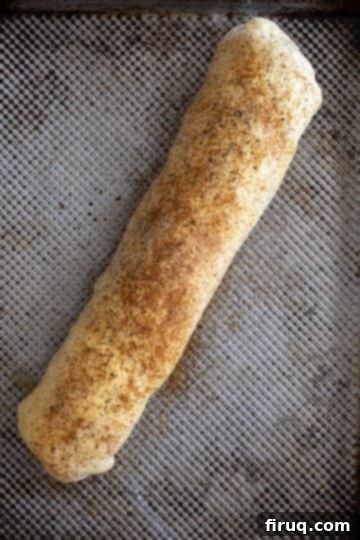
Step 6: Egg Wash and Season.
Once your loaf is formed, place it seam-side down on an oiled baking pan. In a small bowl, lightly beat one egg. Then, brush the entire top and sides of the bread evenly with the egg wash. This egg wash is essential for achieving that beautiful, glossy golden-brown crust. Finally, generously season the top of the bread with a mixture of paprika, garlic powder, salt, and black pepper. These spices not only add flavor but also create a visually appealing finish.
Step 7: Bake to Golden Perfection.
Bake the sausage bread in your preheated oven for approximately 30 minutes, or until the bread is a deep, appealing golden brown and the internal temperature reaches 200-210°F (93-99°C). The crust should look crisp and inviting, and the cheese should be bubbling just beneath the surface. Once baked, remove the bread from the oven and allow it to cool on the baking pan for 5-10 minutes. This cooling period helps the cheese set and prevents the filling from spilling out when sliced. Slice into thick pieces and serve warm with your favorite marinara sauce for dipping. Enjoy!
Pro-Tips for Perfect Italian Sausage Bread
Achieving a perfectly golden, cheesy, and satisfying Italian Sausage Bread is easy with these expert tips:
- Dough Thickness is Key: When rolling the dough out, it’s vital to avoid making it too thin. A thin dough, especially when heavily laden with sausage and cheese, is far more likely to fall apart and break during the cooking process as the bread expands. Aim for a consistent ¼ inch thickness to provide enough structural integrity for the rich filling.
- Careful Transferring: This bread gets delightfully heavy! When transferring the rolled loaf from your work surface to the baking pan, make sure you slide your hands underneath the entire length of the bread to provide ample support. Do not attempt to lift it from the ends or center without full support, as it could easily crack open under the considerable weight of ½ a pound of cheese and a pound of sausage.
- Don’t Overfill: While it’s tempting to pack in as much filling as possible, overfilling can lead to a messy bake with cheese and sausage oozing out. Stick to the recommended quantities for a well-balanced loaf that holds its shape.
- Score the Top: Before baking, use a sharp knife to make a few diagonal slits across the top of the loaf. This not only adds a rustic, professional look but also allows steam to escape, preventing the bread from bursting unevenly and promoting an even bake.
- Serve Warm for Best Results: While Italian Sausage Bread is delicious at room temperature, it’s truly at its best when served warm, straight from the oven. The cheeses are perfectly melted and gooey, and the crust is wonderfully crisp.
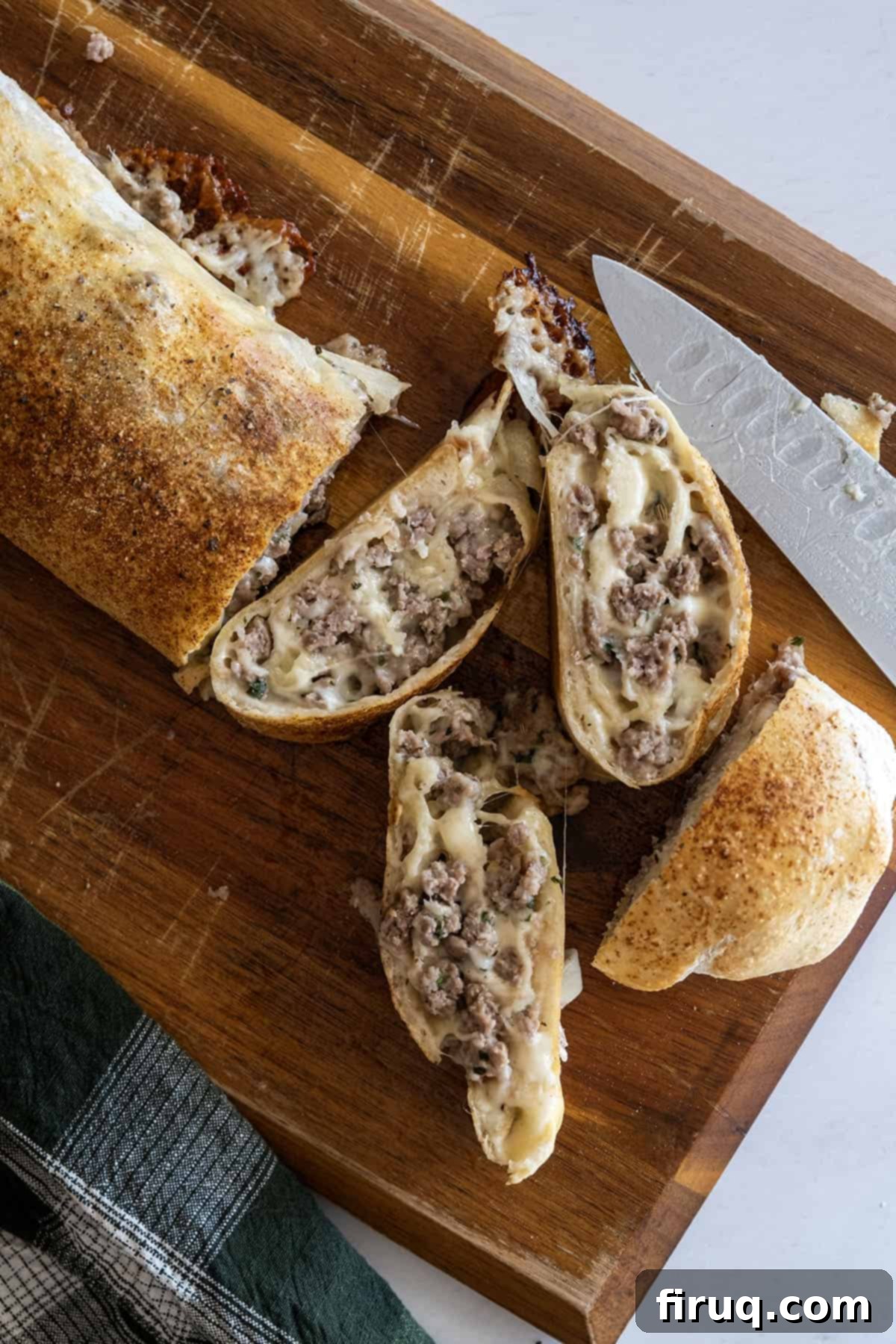
Creative Variations: Ways to Customize Your Italian Sausage Bread!
One of the best things about this Italian Sausage Bread recipe is its versatility. You can easily adapt it to your taste or what you have on hand. Here are some fantastic ideas to get creative:
- Embrace Olives for Extra Zing: A fantastic addition to our sausage bread recipe is olives. We absolutely love to add thinly sliced black olives (or even Kalamata olives for a stronger flavor) to the filling for an extra burst of briny flavor. However, since not everyone is an olive enthusiast, we often prepare two loaves: one with olives and one classic version.
- Go Green with Broccoli Rabe: For a delightful touch of bitterness and texture, you could also add sautéed broccoli rabe to the loaf. Simply cook and chop the broccoli rabe, then replace about half of the sausage quantity with this flavorful green. It pairs wonderfully with the rich sausage and cheese.
- Hearty Meatless Option: My dad has a wonderful variation where he loves to make this bread completely meatless, using only Swiss cheese and garlic-sautéed broccoli! The Swiss cheese offers a distinct, nutty flavor that complements the earthy broccoli beautifully.
- Explore Different Meats: Instead of Italian sausage, why not try other cold cuts? Our popular pepperoni stromboli is a testament to how well other meats work in this format! Sliced ham, salami, or even thinly sliced prosciutto could create unique and equally delicious variations.
- Veggie Power Stromboli: For a lighter, vegetable-packed option, try incorporating a mix of broccoli and spinach, similar to our Veggie Stromboli. Just be sure to sauté and drain any excess moisture from the vegetables before adding them to the dough.
- Dipping Sauce Adventures: Don’t limit yourself to classic marinara! I love to switch up the dipping sauces we use. Try dipping your sausage bread in a luscious creamy red pepper sauce for a smoky, sweet counterpoint, or a vibrant pink sauce for a rich and tangy experience. A simple garlic aioli or a spicy arrabbiata sauce would also be fantastic.
Common Questions About Italian Sausage Bread
Here are answers to some frequently asked questions about making and serving Italian Sausage Bread:
While “Italian Sausage Bread” is the common English name, a similar Sicilian-style sausage bread is known as Bignolati. It’s traditionally served on festive occasions like Christmas and New Year’s Eve, much like this recipe is popular during holidays.
Absolutely! Both hot or sweet Italian sausage work exceptionally well, depending entirely on your personal preference. Sweet Italian sausage offers a milder, aromatic flavor profile, while hot Italian sausage provides a delicious spicy kick. You can even mix half hot and half sweet for a balanced flavor.
Yes, you certainly can! After you roll out the dough, instead of rolling it into one large loaf, you can slice the dough into 8 equal rectangular portions. Place these on a baking pan, fill them individually, then roll them into smaller logs to bake. You will still need to apply an egg wash and season them. For detailed rolling and baking instructions for individual portions, you can follow the steps for our pepperoni stromboli and simply substitute the pepperoni with your cooked Italian sausage.
To prevent a soggy dough, make sure to thoroughly brown your sausage and drain any excess grease before adding it to the dough. Additionally, allow the sausage to cool completely or at least to lukewarm temperature. Hot or greasy fillings can break down the dough and lead to a less-than-perfect texture.
Storage and Reheating Tips for Italian Sausage Bread
Italian Sausage Bread is fantastic fresh, but it also stores and reheats beautifully, making it perfect for meal prepping or enjoying later. Here’s how to keep it delicious:
Storing Leftovers
I find it best to only cut the portions we plan to eat immediately. This helps maintain the freshness of the uncut portion. Realistically, we often devour an entire loaf at most family functions! However, in cases where there are leftovers, I will slice up about half the bread, and once the other half has completely cooled, I wrap the entire uncut portion tightly in aluminum foil. It can then be stored in the fridge for 4-5 days or transferred to the freezer for up to 3 months. For freezer storage, an additional layer of plastic wrap around the foil provides extra protection against freezer burn.
Reheating for Optimal Flavor
For reheating, I highly recommend avoiding the microwave, as it tends to make the bread moist and gooey, losing its crisp crust. Instead, for the best results, place individual slices (or the entire wrapped loaf) on a baking tray lined with aluminum foil. If reheating from the fridge, bake in the oven at 350°F (175°C) for 10-15 minutes, or until warmed through and the cheese is melted. If you’re reheating a frozen loaf or slices, allow it to defrost in the fridge overnight for optimal results, then reheat as you would from the fridge. Alternatively, a frozen slice can be baked directly, though it will take longer (around 20-25 minutes). The aim is to get that crispy crust and gooey interior back, almost as good as day one! Much like leftover pizza, Italian Sausage Bread often tastes just as good, if not better, the next day.
Explore More Italian Sausage Delights
If you’re a fan of Italian sausage, you’re in for a treat! This versatile ingredient forms the backbone of countless hearty and flavorful Italian dishes. Here are some more delicious recipes featuring Italian sausage that you’re sure to love, perfect for expanding your culinary repertoire:
- Italian Ring Sausage (Chevalatta)
- Authentic Italian Baked Ziti
- Italian Sausage and Peppers
- Italian Pink Sauce with Sausage
We absolutely love hearing from you! Please leave a comment and a star rating below in the recipe card to let us know what you think of our recipes. Your feedback is invaluable. Feel free to tag us on Instagram @vindelgiudice when you share your delicious creations!
📖 Recipe: Classic Italian Sausage Bread
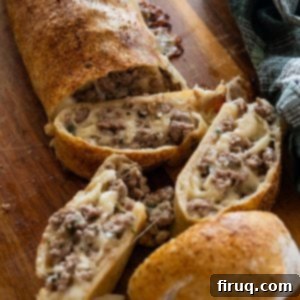
Sausage Bread
Vincent DelGiudice
Pin Recipe
15 minutes
30 minutes
45 minutes
Appetizer
Italian
8 servings
470 kcal
Equipment
-
1 sheet pan
Ingredients
- 1 large pizza dough (approx. 2 lbs)
- 1 lb sweet or hot Italian Sausage, crumbled
- ¼ lb sliced mozzarella cheese
- ¼ lb sliced provolone cheese
- ½ cup grated Parmesan cheese
- 1 large egg, for egg wash
- 1 tablespoon paprika
- 1 tablespoon garlic powder
- 1 teaspoon salt
- 1 teaspoon black pepper
Instructions
-
In a large pan on medium-high heat, brown the Italian sausage, breaking it up with a spoon until no pink remains. Drain any excess grease and set the sausage aside to cool slightly. While the sausage cools, preheat your oven to 375℉ (190°C).
-
On a heavily floured surface, roll out your pizza dough into a rectangular shape, about ¼ inch thick. Layer the sliced mozzarella and provolone cheeses evenly across the dough, leaving a small border (approx. 1 inch) around the edges. Sprinkle the Parmesan cheese over the sliced cheeses, then evenly spread the cooled crumbled sausage across the dough.
-
Starting from one long end, carefully roll the dough into a tight log or loaf. As you roll, fold the short edges of the dough inwards to ensure the filling is completely sealed. Place the rolled loaf, seam-side down, on an oiled baking pan. In a small bowl, whisk the egg to create an egg wash, then brush it generously over the entire top and sides of the bread. Finally, sprinkle the paprika, garlic powder, salt, and black pepper evenly over the top of the loaf.
-
Bake in the preheated oven for 30 minutes, or until the bread is a beautiful golden brown and the cheese is bubbly. Remove from the oven and let the bread cool for 5-10 minutes on the pan before slicing. Serve warm with your favorite marinara sauce for dipping.
Notes
- When rolling the dough out, avoid letting it become too thin. The thinner the dough is, the more likely it is to fall apart and break during the cooking process while the bread is expanding under the weight of the filling.
- When transferring the bread from your work surface to the baking pan, make sure you hold underneath the entire length of the bread to prevent it from cracking open or tearing under the weight of the sausage and cheese.
- Ensure your cooked sausage is cooled before adding it to the dough. Hot sausage can make the dough difficult to handle and potentially greasy.
Nutrition
Carbohydrates: 29g
Protein: 21g
Fat: 29g
Saturated Fat: 12g
Polyunsaturated Fat: 3g
Monounsaturated Fat: 11g
Trans Fat: 0.003g
Cholesterol: 89mg
Sodium: 1561mg
Potassium: 219mg
Fiber: 1g
Sugar: 0.4g
Vitamin A: 730IU
Vitamin C: 1mg
Calcium: 269mg
Iron: 1mg
